Design and Analysis of a Superconducting Homopolar Inductor Machine for Aerospace Application
Abstract
:1. Introduction
2. Topology and Operation Principle
3. Electromagnetic Performance Design
3.1. Calculation of Main Structure Parameters
3.2. Calculation of Electromagnetic Parameters
3.3. Numerical Analysis of Electromagnetic
4. Mechanical Performance
4.1. Structure Analysis of Rotor
4.2. Weight-Saving Design of Rotor
5. Conclusions
Author Contributions
Funding
Data Availability Statement
Conflicts of Interest
Nomenclature
| m1 | Phase number of armature |
| I | Phase current |
| kdp | Winding coefficient |
| Φ | Magnetic flux per pole |
| αδ | Pole arc coefficient |
| lef | Effective length of armature |
| A | Armature winding line-load |
| Fgap | Magnetomotive force |
| gmin | Minimum the airgap length |
| if | Excitation current |
| ΛL | Permeability function of left air gap |
| Ni,j,k(θ) | Winding function |
| E | Back EMF |
| kNm | Waveform factor |
| f | Electric frequence |
| Bmax | Maximum value of air-gap flux density |
| τ | Pole pitch |
| n | Synchronous speed |
| D | Armature diameter |
| Λmax | Maximum of permeability |
| Nf | Number of turns of excitation winding |
| μ0 | Vacuum permeability |
| ΛR | Permeability function of right air gap |
| ωmec | Mechanical angular velocity of rotor |
References
- Dezhin, D.; Ivanov, N.; Kovalev, K.; Kobzeva, I.; Semenihin, V. System Approach of Usability of HTS Electrical Machines in Future Electric Aircraft. IEEE Trans. Appl. Supercond. 2018, 28, 1–5. [Google Scholar] [CrossRef]
- Zhang, Y.; Cheng, Y.; Qu, R.; Li, D.; Gao, Y.; Wang, Q. AC Loss Analysis and Modular Cryostat Design of a 10-MW High-Temperature Superconducting Double Stator Flux Modulation Machine. IEEE Trans. Ind. Applicat. 2022, 58, 7153–7162. [Google Scholar] [CrossRef]
- Liu, Y.; Ou, J.; Cheng, Y.; Schreiner, F.; Zhang, Y.; Vargas-Llanos, C.; Grilli, F.; Qu, R.; Doppelbauer, M.; Noe, M. Investigation of AC Loss of Superconducting Field Coils in a Double-Stator Superconducting Flux Modulation Generator by Using T-A Formulation Based Finite Element Method. Supercond. Sci. Technol. 2021, 34, 055009. [Google Scholar] [CrossRef]
- Qu, R.; Liu, Y.; Wang, J. Review of Superconducting Generator Topologies for Direct-Drive Wind Turbines. IEEE Trans. Appl. Supercond. 2013, 23, 5201108. [Google Scholar] [CrossRef]
- Chow, C.C.T.; Ainslie, M.D.; Chau, K.T. High Temperature Superconducting Rotating Electrical Machines: An Overview. Energy Rep. 2023, 9, 1124–1156. [Google Scholar] [CrossRef]
- Cheng, M.; Zhu, X.; Wang, Y.; Wang, R.; Wang, W. Effect and Inhibition Method of Armature-Reaction Field on Superconducting Coil in Field-Modulation Superconducting Electrical Machine. IEEE Trans. Energy Convers. 2020, 35, 279–291. [Google Scholar] [CrossRef]
- Li, X.; Liu, S.; Wang, Y. Design and Analysis of a Stator HTS Field-Modulated Machine for Direct-Drive Applications. IEEE Trans. Appl. Supercond. 2017, 27, 1–5. [Google Scholar] [CrossRef]
- Jia, S.; Qu, R.; Li, J.; Fang, H.; Li, D. A Novel Vernier Reluctance Fully Superconducting Direct Drive Synchronous Generator With Concentrated Windings for Wind Power Application. IEEE Trans. Appl. Supercond. 2016, 26, 1–5. [Google Scholar] [CrossRef]
- Sivasubramaniam, K.; Zhang, T.; Lokhandwalla, M.; Laskaris, E.T.; Bray, J.W.; Gerstler, B.; Shah, M.R.; Alexander, J.P. Development of a High Speed HTS Generator for Airborne Applications. IEEE Trans. Appl. Supercond. 2009, 19, 1656–1661. [Google Scholar] [CrossRef]
- Berg, F.; Palmer, J.; Miller, P.; Dodds, G. HTS System and Component Targets for a Distributed Aircraft Propulsion System. IEEE Trans. Appl. Supercond. 2017, 27, 1–7. [Google Scholar] [CrossRef]
- Sivasubramaniam, K.; Laskaris, E.T.; Shah, M.R.; Bray, J.W.; Garrigan, N.R. High-Temperature Superconducting Homopolar Inductor Alternator for Marine Applications. IEEE Trans. Appl. Supercond. 2008, 18, 1–6. [Google Scholar] [CrossRef]
- Lokhandwalla, M.; Haran, K.S.; Alexander, J.P. Scaling Studies of High Speed High Temperature Superconducting Generator. In Proceedings of the 2012 XXth International Conference on Electrical Machines, Marseille, France, 2–5 September 2012; IEEE: Piscataway, NJ, USA, 2012; pp. 751–756. [Google Scholar]
- Jeong, J.-S.; An, D.; Hong, J.-P.; Kim, H.-J.; Jo, Y.-S. Design of a 10-MW-Class HTS Homopolar Generator for Wind Turbines. IEEE Trans. Appl. Supercond. 2017, 27, 1–4. [Google Scholar] [CrossRef]
- Kalsi, S.; Hamilton, K.; Buckley, R.; Badcock, R. Superconducting AC Homopolar Machines for High-Speed Applications. Energies 2018, 12, 86. [Google Scholar] [CrossRef]
- Pan, Y.; Yang, J.; Li, Q.; Luo, X.; Huang, S.; Gao, C.; Ma, J. Design of HTS Excitation Coil for Homopolar Inductor Machine Considering Critical Current Reduction of Local Turn. IEEE Trans. Ind. Appl. 2024, 1–9. [Google Scholar] [CrossRef]
- Sivasubramaniam, K.; Laskaris, E.T.; Lokhandwalla, M.; Zhang, T.; Bray, J.W.; Gerstler, B.; Shah, M.R.; Alexander, J.P. Development of a High Speed Multi-Megawatt HTS Generator for Airborne Applications. In Proceedings of the 2008 IEEE Power and Energy Society General Meeting—Conversion and Delivery of Electrical Energy in the 21st Century, Pittsburgh, PA, USA, 20–24 July 2008; IEEE: Piscataway, NJ, USA, 2008; pp. 1–4. [Google Scholar]
- Li, W.; Chau, K.T.; Ching, T.W.; Wang, Y.; Chen, M. Design of a High-Speed Superconducting Bearingless Machine for Flywheel Energy Storage Systems. IEEE Trans. Appl. Supercond. 2015, 25, 1–4. [Google Scholar] [CrossRef]
- Pan, Y.; Yang, J.; Li, Q.; Huang, S.; Gao, C.; Ma, J. Investigation and Suppression of External Alternating Field of HTS Excitation Coil in Homopolar Inductor Machine. IEEE Trans. Magn. 2024, 1. [Google Scholar] [CrossRef]
- Ma, J.; Pan, Y.; Luo, X.; Xiao, H.; Yang, J.; Simpson, N.; Mellor, P. Design of a 10 kW Superconducting Homopolar Inductor Machine Based on HTS REBCO Magnet. IEEE Trans. Appl. Supercond. 2024, 34, 1–7. [Google Scholar] [CrossRef]
- Pan, Y.; Yang, J.; Li, Q.; Luo, X.; Huang, S.; Ma, J. Optimal Design of a High Temperature Superconducting Homopolar Inductor Machine. In Proceedings of the 2023 26th International Conference on Electrical Machines and Systems (ICEMS), Zhuhai, China, 5–8 November 2023; pp. 3920–3925. [Google Scholar]
- Dai, S.; Yang, J.; Liu, H.; Feng, Y.; Huang, S. Comparative Study on the Performance of High-Speed IPM Motor with Single-Layer PM for Electric Spindle. In Proceedings of the 2022 IEEE 5th International Electrical and Energy Conference (CIEEC), Nangjing, China, 27–29 May 2022; pp. 963–968. [Google Scholar]
- Ye, C.; Yang, J.; Xiong, F.; Zhu, Z.Q. Relationship Between Homopolar Inductor Machine and Wound-Field Synchronous Machine. IEEE Trans. Ind. Electron. 2020, 67, 919–930. [Google Scholar] [CrossRef]
- Lou, Z.; Yu, K.; Wang, L.; Ren, Z.; Ye, C. Two-Reaction Theory of Homopolar Inductor Alternator. IEEE Trans. Energy Convers. 2010, 25, 677–679. [Google Scholar] [CrossRef]
- Li, Q.; Yang, J.; Huang, S.; Liu, P.; Feng, Y.; Wang, L. No-Load Electromagnetic Performance Analysis of a Mechanically Modulated Permanent Magnet Homopolar Inductor Machine. IEEE Trans. Transp. Electrif. 2022, 8, 1168–1181. [Google Scholar] [CrossRef]
- Yang, J.; Ye, C.; Huang, S.; Li, Y.; Xiong, F.; Zhou, Y.; Xu, W. Analysis of the Electromagnetic Performance of Homopolar Inductor Machine Through Nonlinear Magnetic Equivalent Circuit and Air-Gap Permeance Function. IEEE Trans. Ind. Appl. 2020, 56, 267–276. [Google Scholar] [CrossRef]
- Yang, J.; Liu, P.; Ye, C.; Wang, L.; Zhang, X.; Huang, S. Multidisciplinary Design of High-Speed Solid Rotor Homopolar Inductor Machine for Flywheel Energy Storage System. IEEE Trans. Transp. Electrific. 2021, 7, 485–496. [Google Scholar] [CrossRef]
- Krings, A.; Cossale, M.; Tenconi, A.; Soulard, J.; Cavagnino, A.; Boglietti, A. Magnetic Materials Used in Electrical Machines: A Comparison and Selection Guide for Early Machine Design. IEEE Ind. Appl. Mag. 2017, 23, 21–28. [Google Scholar] [CrossRef]



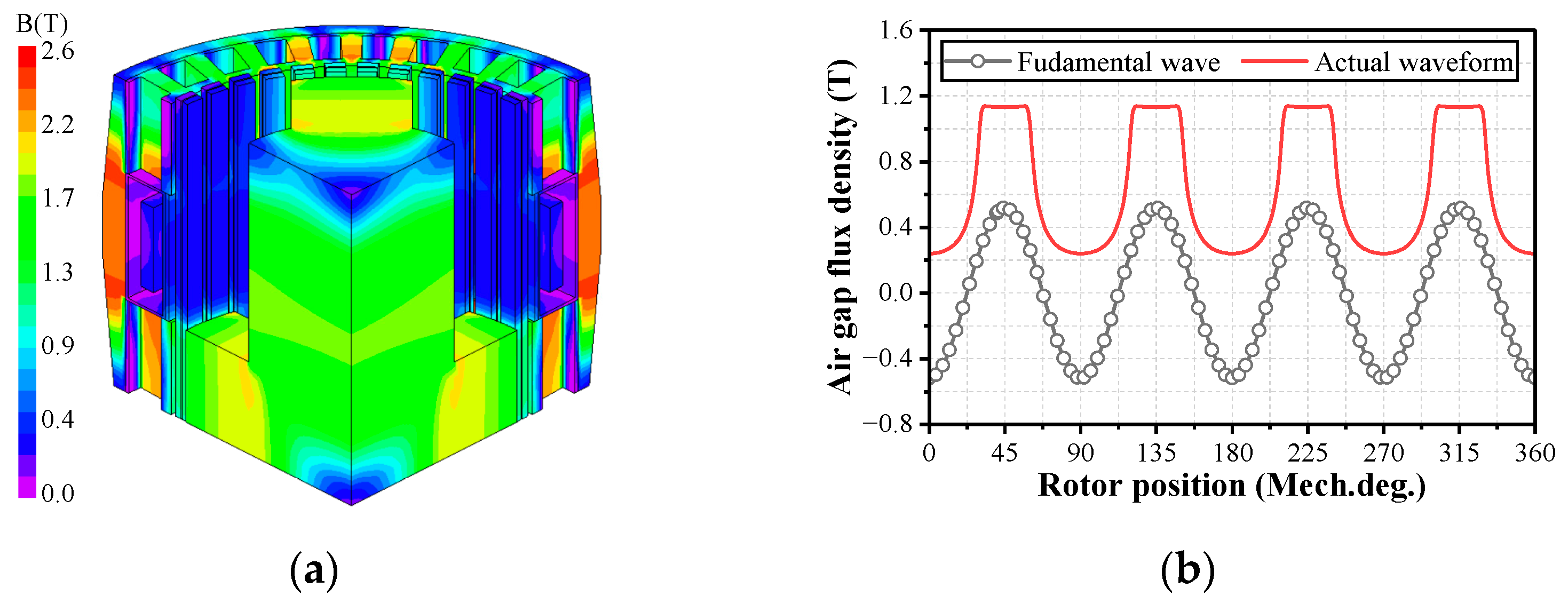
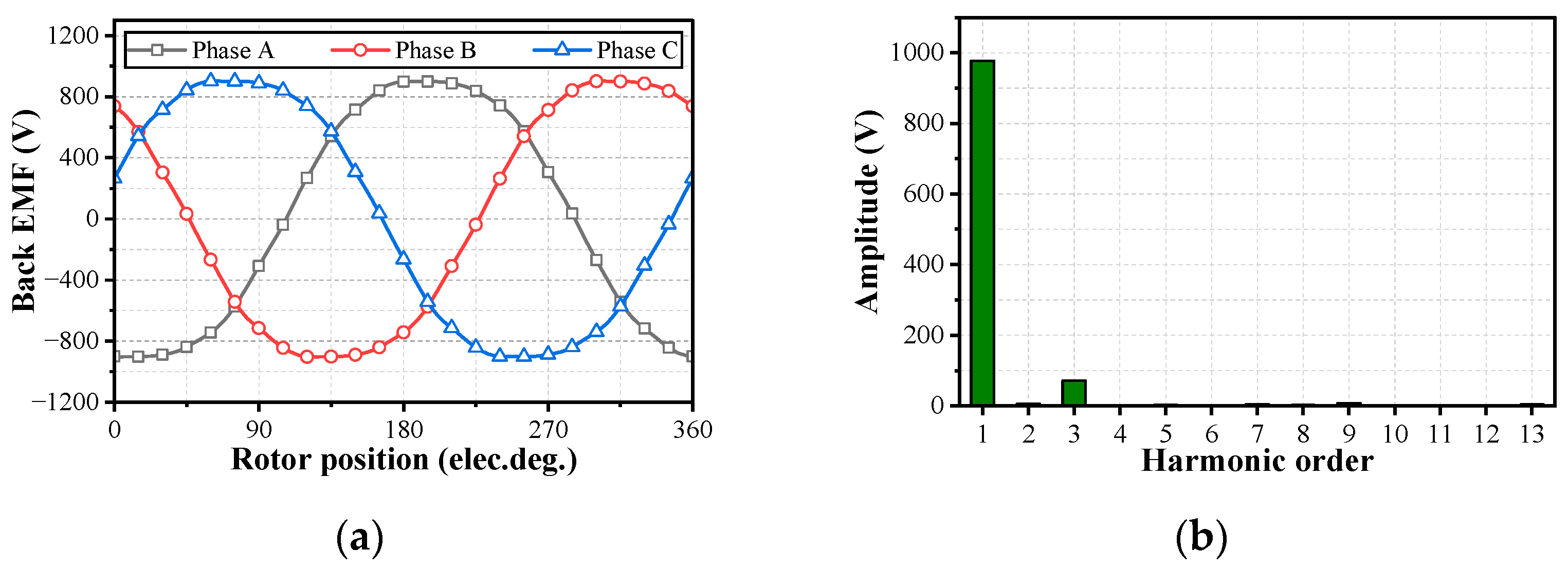
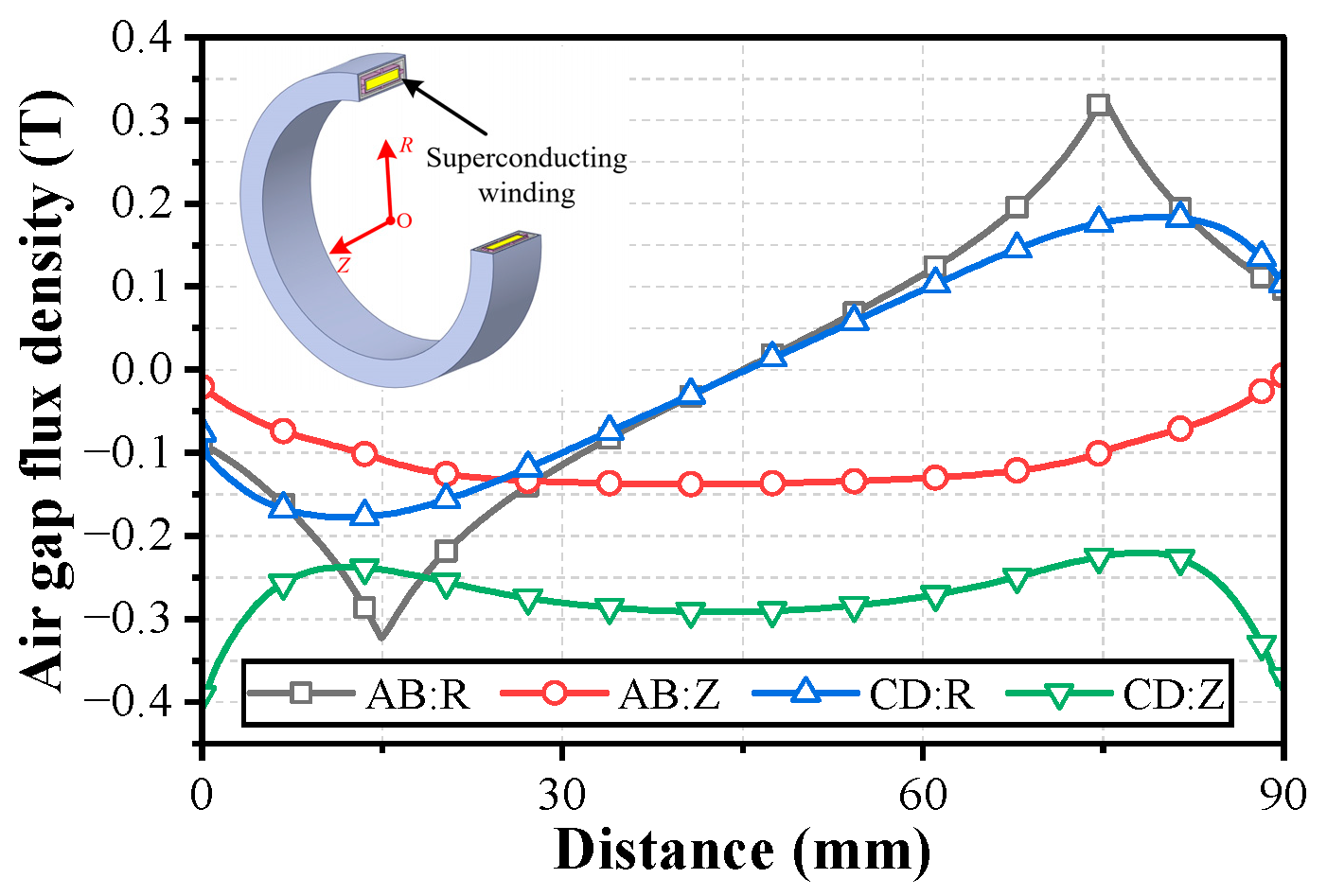
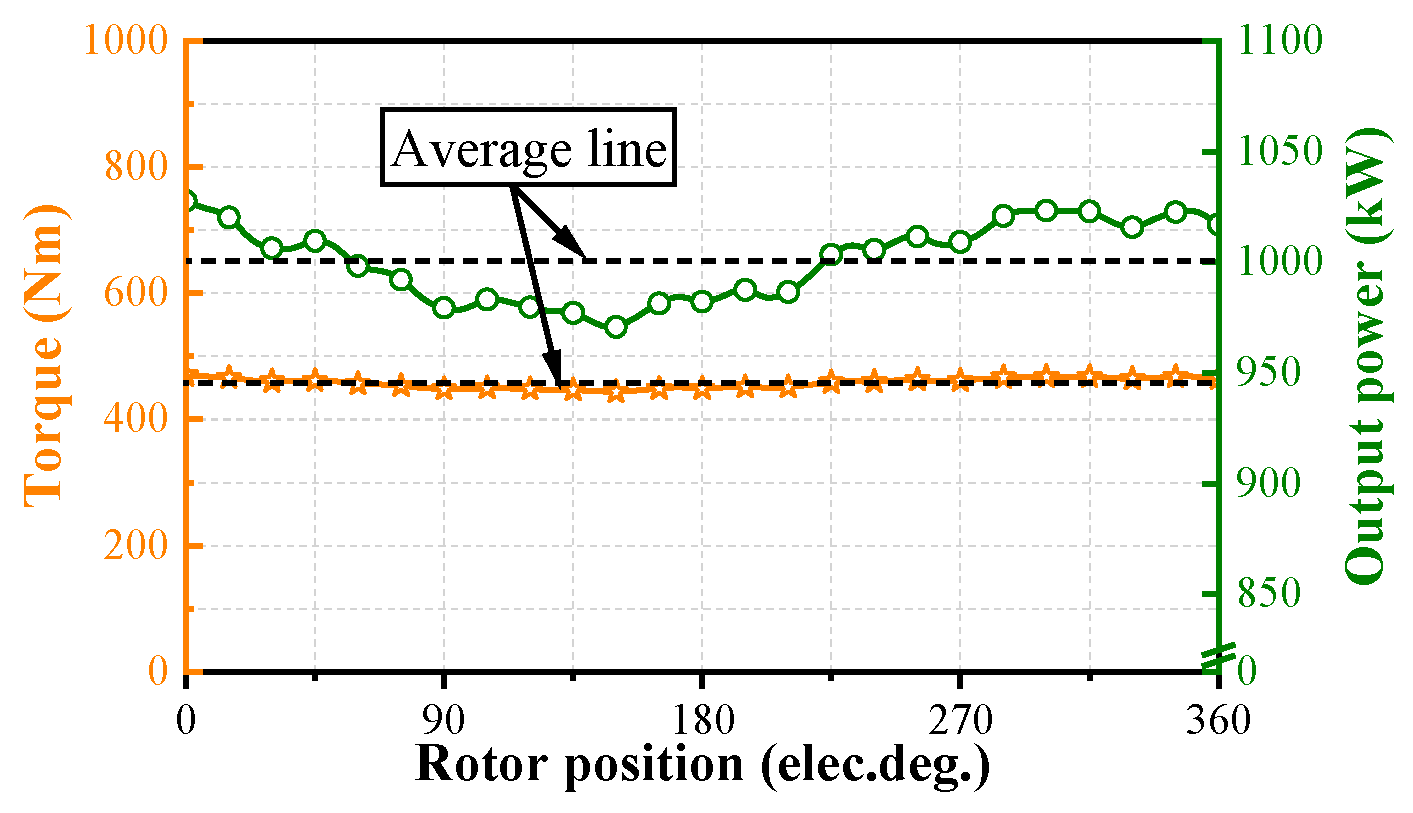
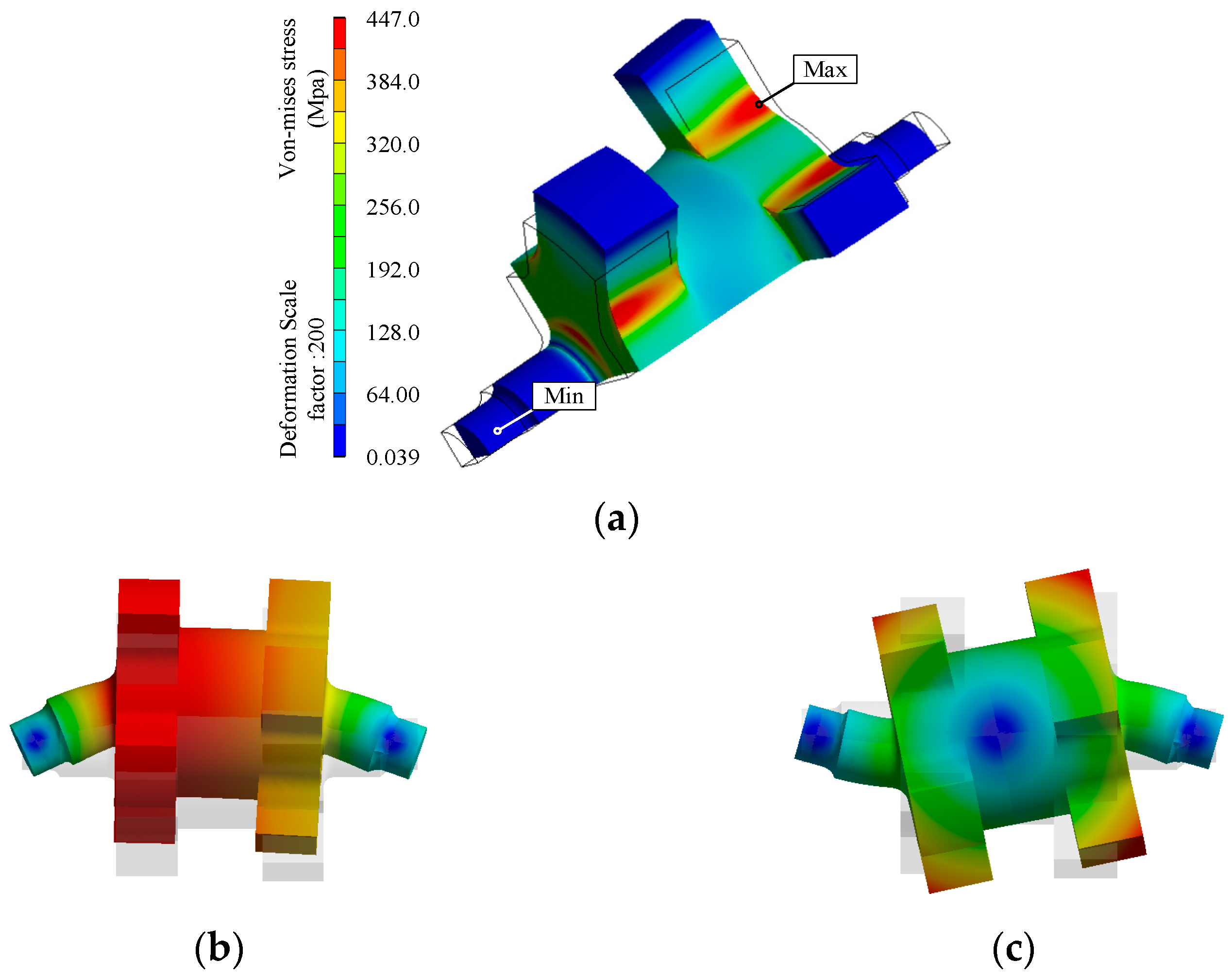

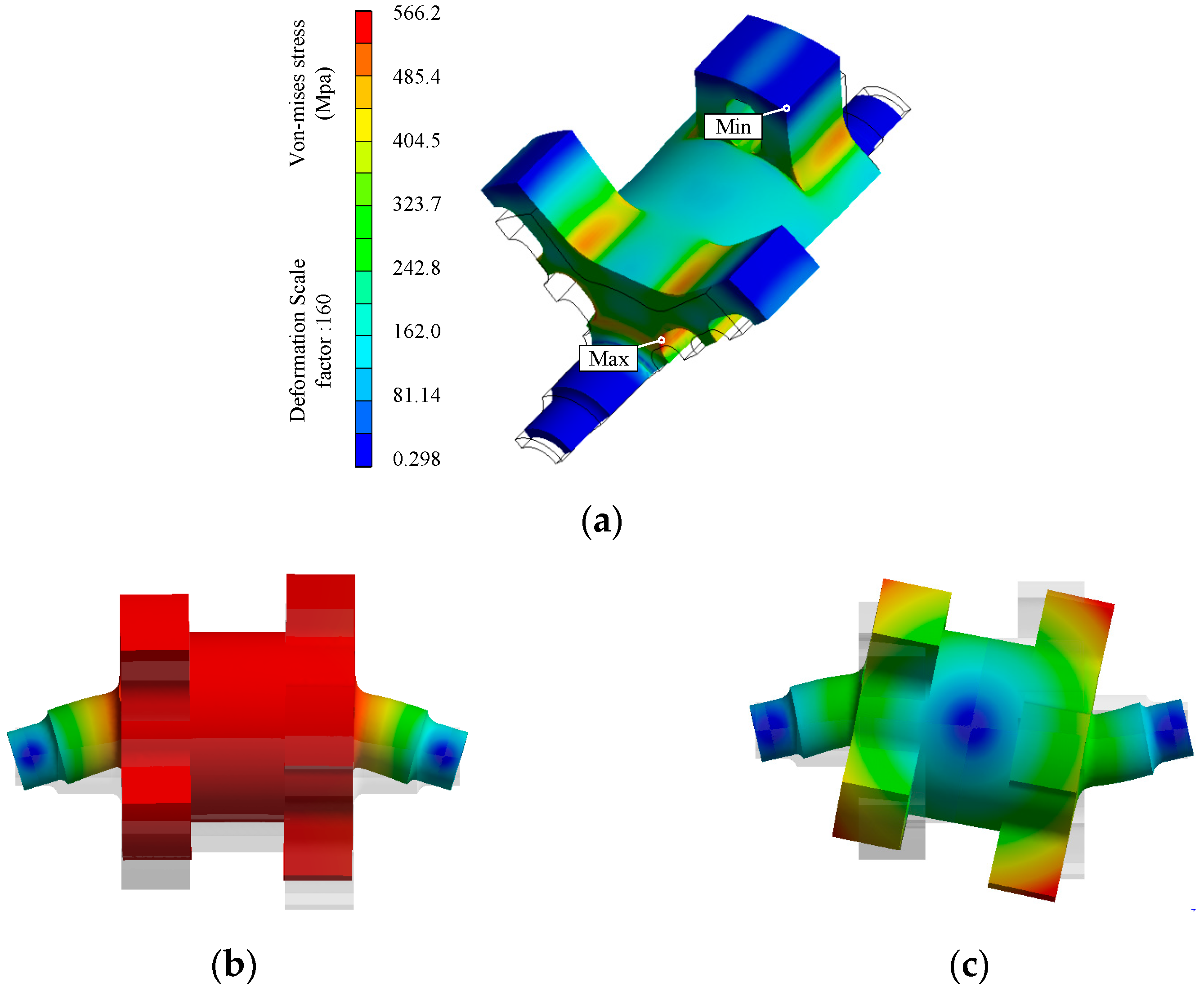

| Components | Materials | Mass (kg) |
|---|---|---|
| Stator | 1J22 | 27.32 |
| Rotor | 40Cr | 66.56 |
| Shell | 1J22 | 35.36 |
| Armature winding | Litz wire | 12.32 |
| Parameters (Unit) | Value |
|---|---|
| Inner diameter of stator yoke (mm) | 316 |
| Outer radius of rotor (mm) | 145 |
| Effective length of the rotor (mm) | 130 |
| Pole-pairs (-) | 4 |
| Coil pitch (-) | 5 |
| Synchronous speed (rpm) | 21,000 |
| Thickness of stator yoke (mm) | 40 |
| Rotor slot depth (mm) | 55 |
| Physical air-gap length (mm) | 13 |
| Virtual slots of the stator (-) | 48 |
| Ampere-turns of exciting winding (AT) | 30,000 |
| Rated power (kW) | 1000 |
| Volume (m3) | Mass (kg) | Moment of Inertia (kg.m2) | |
|---|---|---|---|
| Original rotor | 0.0085 | 66.56 | 0.4235 |
| Mass-reduced rotor | 0.0064 | 50.02 | 0.3476 |
| Volume (m3) | Mass (kg) | Moment of Inertia (kg.m2) | Kilowatt Per Kilogram (kW/kg) | |
|---|---|---|---|---|
| SHIM with original rotor | 13.0 | 1000 | 97.4 | About 7.1 |
| SHIM with mass-reduced rotor | 13.0 | 788 | 98.5 | About 6.3 |
| SHIM with mass-reduced rotor | 16.5 | 1000 | 97.1 | About 8.0 |
Disclaimer/Publisher’s Note: The statements, opinions and data contained in all publications are solely those of the individual author(s) and contributor(s) and not of MDPI and/or the editor(s). MDPI and/or the editor(s) disclaim responsibility for any injury to people or property resulting from any ideas, methods, instructions or products referred to in the content. |
© 2024 by the authors. Licensee MDPI, Basel, Switzerland. This article is an open access article distributed under the terms and conditions of the Creative Commons Attribution (CC BY) license (https://creativecommons.org/licenses/by/4.0/).
Share and Cite
Wang, J.; Guo, C.; Zhou, W.; Wan, Q. Design and Analysis of a Superconducting Homopolar Inductor Machine for Aerospace Application. Electronics 2024, 13, 2830. https://doi.org/10.3390/electronics13142830
Wang J, Guo C, Zhou W, Wan Q. Design and Analysis of a Superconducting Homopolar Inductor Machine for Aerospace Application. Electronics. 2024; 13(14):2830. https://doi.org/10.3390/electronics13142830
Chicago/Turabian StyleWang, Jiabao, Chao Guo, Wanyu Zhou, and Qin Wan. 2024. "Design and Analysis of a Superconducting Homopolar Inductor Machine for Aerospace Application" Electronics 13, no. 14: 2830. https://doi.org/10.3390/electronics13142830
APA StyleWang, J., Guo, C., Zhou, W., & Wan, Q. (2024). Design and Analysis of a Superconducting Homopolar Inductor Machine for Aerospace Application. Electronics, 13(14), 2830. https://doi.org/10.3390/electronics13142830





